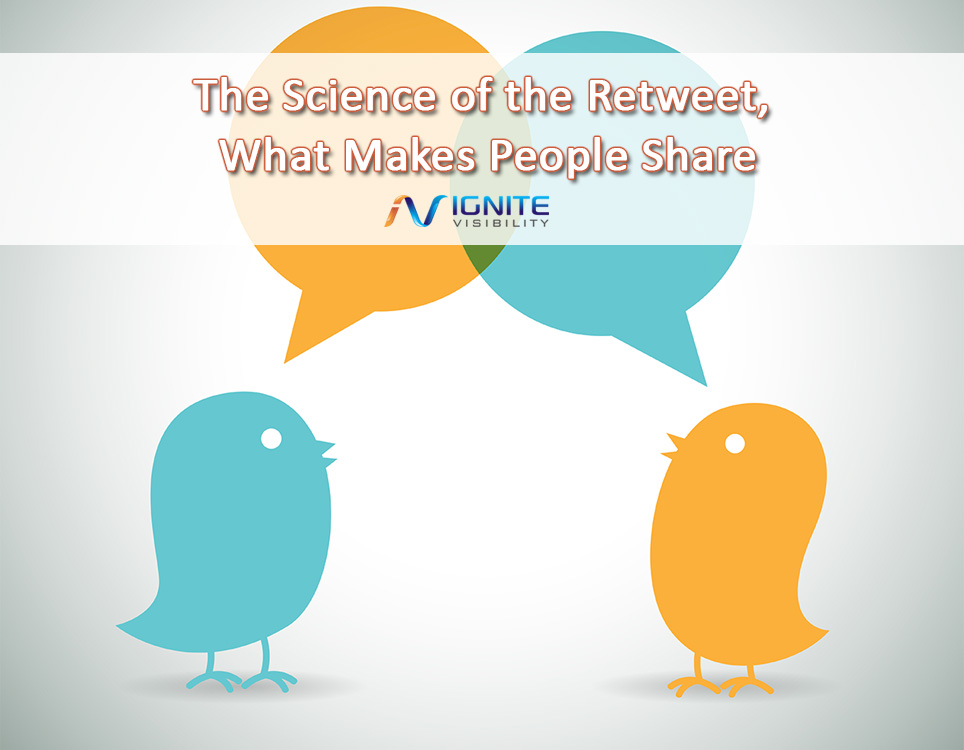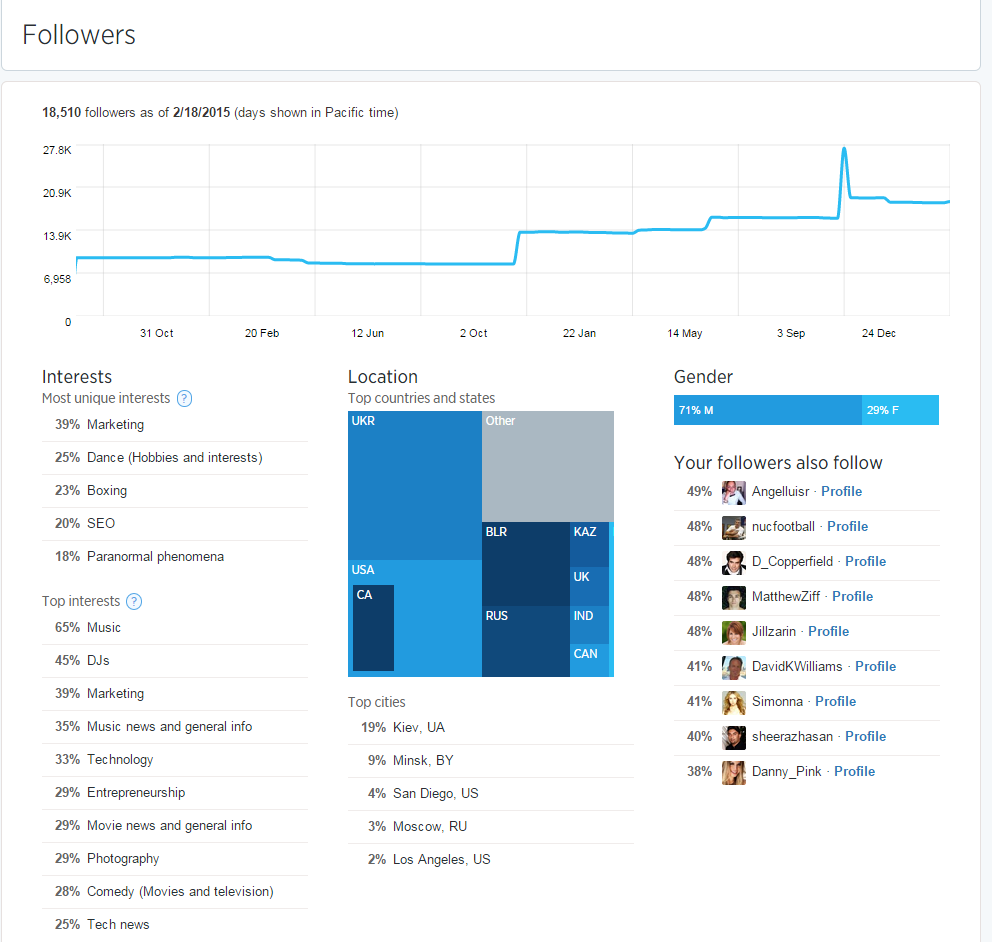When most people think about using Twitter, they don’t tend to think in very scientific terms. Yet, the truth is, all of our following, favoriting and retweeting is more than just random social activity–there’s an actual science and psychology behind the way we tweet. And best of all, you can use this information to you advantage.
Thanks to a growing amount of research on Twitter trends and what’s behind our seemingly random behavior, you can actually better harness the power of Twitter. By understanding the science of the retweet and what makes people share, you can help to increase your chances for retweets, maximize your reach on Twitter, and help drive more traffic and conversions for you business.

The Science of the Retweet, What Makes People Share
Now that you’ve taken steps to optimize your Twitter activity to rank higher on Google, let’s take a look at how you can increase the likelihood that your tweets will be retweeted. Keep in mind, some of these techniques may seem straightforward, but sometimes we ignore the simplest of approaches despite our best intentions. With over 270 million active Twitter users at this point, and over a third (37%) of users saying that they buy from brands that they follow, making the most of the science of the retweet can prove very worthwhile.
-
Understand Your Audience
People follow others who they consider to be thought leaders in their industry. They look for and retweet content that is credible, intelligent and valuable to them, so make sure your tweets speak to that desire. Research also indicates that tweets with readability levels greater than grade 6 are more likely to be retweeted, so take the time to craft thoughtful, grammatically correct tweets that will resonate with your target audience. And use language and phrases that your followers would actually use, not dry or awkward marketing language. Make sure you check out your Twitter analytics to get an idea of the base.
-
Tweet At The Optimal Time
Timing plays a major role in the likelihood that your tweets will be retweeted, and even seen at all. According to social media guru Dan Zarrella’s The Science of Retweets, between 2pm and 6pm EST is the best time to ask for a retweet (and notice we say “ask for”, more on that soon).

-
Ask For Retweets
This one may surprise many people for its simplicity, but sometimes all you have to do is ask for a retweet. Simply by adding “Please Retweet”, you increase your chances of being retweeted by 160%. Even including “Please RT” will help to dramatically your reach. Twitter users generally don’t seem to be bothered by such a direct ask, though it’s probably a good idea to vary your tweets and only go for the ask on the more important ones.
-
Tweet Links
As I mentioned before, many people use Twitter to find useful information, as well as news or help with something. Multiple studies have revealed that news updates and instructional posts are two types of content that people retweet the most, which means that referring to an online source with a link that provides useful information will increase your chances of a retweet.
To embed a link in your tweet without taking up too many characters, make the most of url shorteners. Bit.ly is considered the king (or queen?) of URL shorteners, but there are other great services as well, like Ow.ly and Su.pr.
-
Use Images
Another very effective tool for increasing your retweet likelihood is by including images with Pic.Twitter.com, Twitter’s native uploader. How effective? Tweets with images from Pic.Twitter.com are 94% more likely to get retweeted, according to Dan Zarrella. Tweets including Twitpic links are also 64% more likely to be retweeted. But be warned: tweets that include Facebook and Instagram image links are actually less likely to be retweeted.
-
Avoid Boring Words and Mundane Activities
The long-standing criticism of tweets has always been that nobody wants to know what you had for breakfast (unless you’re a nutritionist or health foods guru, I suppose), and that holds true for most mundane activities.
(By the way, make sure to read this related post on the 15 most powerful words in marketing)
Here are some words to avoid using if you want to increase your retweet-able odds: game, going, haha, lol, but, watching, work, home, night, bed, well, sleep, gonna, hey, tomorrow, tired, some, back, bored, listening. All of these common-use and boring words are a big turn off for retweets, so steer clear of them.
-
Use Retweetable Words
The flip side of those boring words is the 20 most retweeted words; according to Dan Zarella’s retweet study. Here they are in descending order of effectiveness: you, Twitter, please, retweet, post, blog, social, free, media, help, please retweet, great, social media, 10, follow, how to, top, blog post, check out, new blogpost.
-
Use Hashtags
If you aren’t already using hashtags, now is the time to start. Just don’t go overboard and use #extremelylonghashtagsthataretoospecific and don’t use them #toomuch or it will look like #spam. Using at least one hashtagged word in your tweet can help increase the chances that people who aren’t following you will find you tweets, and either become a new follower or retweet you.
Hashtags can be especially effective if you are hosting a live, in-person or online event, as people will more likely follow and retweet the topics being discussed. There’s even a whole science behind choosing the right hashtags for your purposes and many tools to help you find the best ones for your business.
-
Leave Room For Retweets
This is another important logistical aspect of increasing your retweets that many overlook despite being common sense once you think about it. If you’re using all 140 characters of your tweet, your followers will have to edit your tweets if they want to add a comment and retweet. When people retweet, they often want to add in a short opinion, such as “good read:”, “check this out:” or “solid article”. But if they have to take the time to shorten your tweet, chances are they’re much less likely to retweet.
Twitter is all about an economy of words, so try to keep your tweets between 100 and 115 characters to increase your chances of retweets. By not crowding every last inch of your tweets, you’ll also keep your tweets uncluttered and make them easier to read (and retweet!).
-
Discuss Current and Relevant Topics
You also want to be sure to tweet industry specific, but not company specific. In other words don’t flood your followers feeds with self-promotional tweets, which tend to turn off followers and are less likely to be retweeted. Instead, focus on being an industry expert and share relevant information that your target audience craves or provide answers to problems they want to solve.
Discussing current events will also help increase your chances of retweets. Nearly 80% of retweeted content is about news and more than 50% is entertainment-related. Look for newsworthy content to share that is relevant to your audience and add your own unique voice or perspective when you share.
Bonus: Twitter Conversion Tracking
Although Twitter isn’t know for driving a lot of revenue, you can set up conversion tracking and it is a good idea to do so.

Conclusion
Clearly there are smart ways to use Twitter effectively to reach a larger audience and increase your chances for retweets. Implementing these techniques and approaches will take time and a bit of research, but the potential pay-off can be huge. Using the science of the retweet is the key to reaching new audiences and showing others that you are a thought leader in your industry worthy of listening to and sharing.
What techniques or content have you found to increase your chances of retweets? Let us know in the comment section below.
Resources
- “The Science of Retweets Report” (Dan Zarella)
- “The Secret Science of Retweets” (MIT Technology Review)
- “11 Guaranteed Ways To Get Others To Retweet Your Content” (HubSpot)
- “10 Easy Ways to Get More Retweets” (Crazy Egg)
- “The Science of Retweets: 10 Steps to Go Viral on Twitter” (Shopify)

